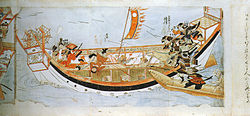Kamakura period
period of Japanese history From Wikipedia, the free encyclopedia
Remove ads
The Kamakura period (鎌倉時代, Kamakura jidai) is a time in the Japanese history from 1185 through 1333 in the history of Japan.[1] This grouping of years is named after city of Kamakura which was the center of power of the Kamakura shogunate.[2]
This article may have too many red links. (October 2015) |
The government of shoguns which was functionally established in 1192 by Minamoto no Yoritomo.[3]
The Kamakura period ended in 1333 with the destruction of the shogunate. Imperial rule was re-established under Emperor Go-Daigo.[4]
Mongol Invasions of Japan (1274, 1281) also happened in this period.
Remove ads
Flourishing of Buddhism
Buddhism expanded during this period. A number of monks founded separate Buddhist sects, including
- • Hōnen, founder of the Jōdo shū sect[5]
- • Shinran, disciple of Hōnen; founder of Jōdo Shinshū[6]
- • Ippen, founder of the Ji sect[7]
- • Dōgen, founder of the Sōtō school of Zen[8]
- • Eisai, founder of the Rinzai school of Zen[9]
- • Nichiren, founder of the sect of Buddhism named after him[10]
The older Buddhist sects such as Shingon and Tendai continued to thrive.
Remove ads
Timeline
- 1185 (Genryaku 2, 24th day of the 3rd month): Taira clan (Heike) defeated at sea by Minamoto Yoshitsune[11]
- 1191 (Kenkyū 2): Esai establishes Zen in Japan[12]
- 1192 (Kenkyū 3): Minamoto Yoritomo appointed as shogun[13]
- 1207 (Ken'ei 1): Hōnen and his followers are exiled[14]
- 1221 (Jōkyū 3): In the Jōkyū War (承久の乱, jōkyū no ran), Emperor Go-Toba tried to take power from the Kamakura shogunate. The effort did not succeed.[15]
- 1252 (Kenchō 2): Great Buddha of Kamakura was put in place at Kōtoku-in.[16]
- November 19, 1274 (Bun'ei 11, 20th day of the 10th month): Kublai Khan sent a fleet and an army to invade Japan; Battle of Bun'ei (文永の役, Bun'ei no eki) or the "Bun'ei War".[17]
- 1281 (Kōan 4): Battle of Kōan (弘安の役, Kōan no eki) or the "Kōan War".[18]
- 1293 (Einin 1): Disastrous earthquake and tsunami hit Sagami Bay and Kamakura, killing 23,034 people.[19]
- 1333 (Genkō 3): Nitta Yoshisada destroys the Kamakura shogunate in the Siege of Kamakura (鎌倉の戦い).[20]
Remove ads
Gallery
- Dai Butsu of Kamakura. Hand-coloured image by Adolfo Farsari, between 1885 and 1890—see 1252 above
- Painting scrolls on the Mongol invasions by Fukuda Taika, 1846 —see 1274 and 1281 above
Related pages
References
Other websites
Wikiwand - on
Seamless Wikipedia browsing. On steroids.
Remove ads


